Basic Components
Two basic circuits are in any DC motor: the armature (the device that rotates, sometimes referred to as a rotor) and the field (the stationary part, sometimes referred to as a stator). The two components magnetically interact with one another to produce rotation in the armature. We will take a closer look at each of the parts and how they interact.
Figure 3-1 indicates a very simplistic view of the basic parts of the DC motor.
As seen in Figure 3-1, the armature and the field are two separate circuits and are physically next to each other to promote magnetic interaction.
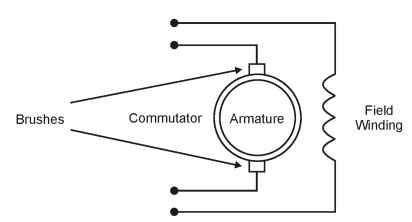
Figure 3-1. DC motor basic parts
The armature has an integral part, called a commutator. The commutator acts as an electrical switch, always switching the polarity of the magnetic flux to ensure that a “repelling” force taking place. The armature rotates as a result of the repelling motion created by the magnetic flux of the armature, in opposition to the magnetic flux created by the field winding.
The physical connection of voltage to the armature is accomplished by a device called brushes. Brushes are made of a carbon material that is in constant contact with the armature’s commutator plates. The brushes are typically spring-loaded to provide constant pressure of the brush to the commutator plates. Figure 3-2 indicates how the armature and field windings are electrically connected.
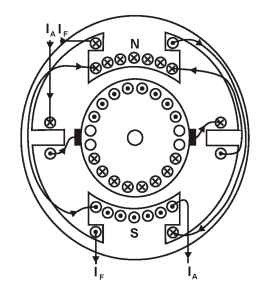
Figure 3-2. Armature and field connections
As seen in Figure 3-2, the leads are brought out away from the windings, and usually are terminated in a conduit box. IF indicates a field winding connection and IA indicates an armature connection. (Note: “I” indicates current, meaning “intensity of current.”)
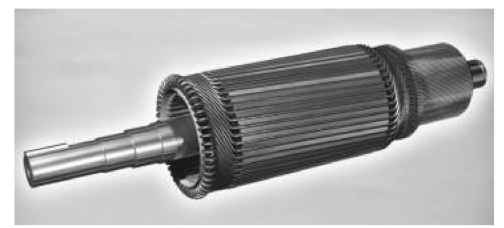
Figure 3-3. Construction of the armature
The armature device would look like that indicated in Figure 3-3.
The windings are fitted inside slots in the armature. These slots are created by a series of iron “laminations” epoxied together into a long, narrow unit. These slots are actually skewed to allow for smooth rotational action at very low speeds. (Magnetic flux has a tendency to “jump” from field to field. When that occurs, a jerking motion is the result. With the windings at an angle, the magnetic interaction between the armature and field winding is dampened, and the jerking motion is greatly reduced.)
Many manufacturers actually have lengthwise holes around the inside center of the armature. This allows additional cooling air to flow through the armature, reducing overheating. Brushes contact the commutator, which is slightly smaller in diameter, compared with the main body of the device (right side of photo).
There are many coils (windings) around the armature to allow for maximum generation of torque. The polarity of the armature coils must be reversed at the precise time to ensure that the repelling action continues. This action is called commutation and takes place when properly aligned brushes are contacting the commutator.
Special windings called commutation windings are installed between the magnetic poles to straighten the magnetic field flowing through the armature. If these windings were not installed, a distortion or bending of the magnetic flux would occur, and reduced motor torque would be the result. Figure 3-4 indicates the location of commutation windings.
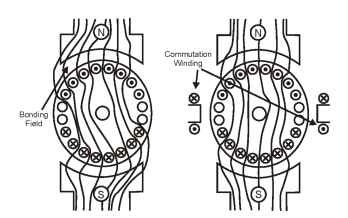
Figure 3-4. Commutation windings
As brushes wear from constant contact with the commutator plates, arcing occurs. Arcing can be reduced by using commutation windings, but some arcing does occur. To reduce arcing, which causes degraded performance, brush replacement is required. The replacement is part of any routine pre-ventative maintenance (PM) program.
The field winding unit is constructed in much the same way, with iron laminations making up the bulk of the device. Windings are inserted lengthwise around the windings. Iron laminations tend to increase the strength of the magnetic flux. Figure 3-5 indicates the typical construction of a motor field winding unit.
There are additional windings that are installed to the magnetic poles of the field windings. These windings are called compensation windings and tend to smooth the field flux across the pole. Without the compensation windings, the left side of the north pole would become saturated because of additional magnetic fields generated by the armature. Figure 3-6 indicates the location of these windings.
At this point, it should be noted that there is another type of DC motor that uses permanent magnets instead of field windings. These types of motors, designated “PM” DC motors, do not need a separate exciter or power supply to generate the field magnetic flux. Only a power supply for the armature is needed. If armature supply voltage is available, the PM DC motor includes all the necessary magnetic features to produce shaft rotation.
Figure 3-7 indicates the relationship of the main parts of a DC motor. These parts may look slightly different, depending on manufacturer, but all DC motors will have these components.
Control of Speed and Torque
The speed of a DC motor is a direct result of the voltage applied. As indicated earlier, the DC motor requires two separate circuits to generate motor torque.
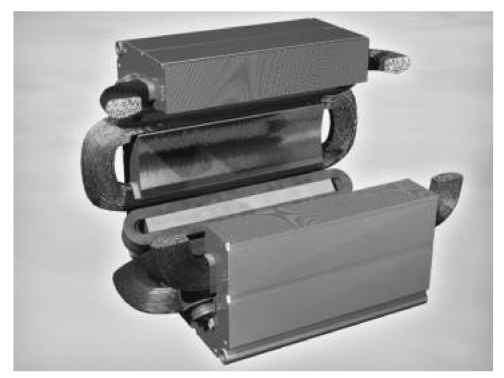
Figure 3-5. Motor field winding construction

Figure 3-6. Compensation windings
Control of Speed
The field receives voltage from a separate power supply, sometimes referred to as a field exciter. This exciter provides power to the field, which in turn generates current and magnetic flux. In a normal operating state, the field is kept at maximum strength, thereby allowing the field winding to develop maximum current and flux. This condition is known as opera-
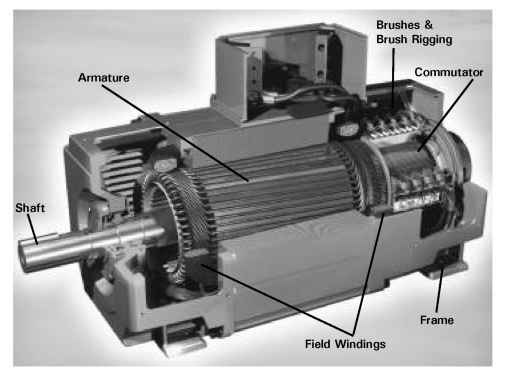
Figure 3-7. Major components of a DC motor
tion in the armature range. (The only way to control the speed is through change in armature voltage.)
The armature power supply applies voltage to the armature through the brushes and the commutator. Basically, the greater the amount of voltage applied, the faster the speed of the motor. We can see this relationship in the formula below:
![]()
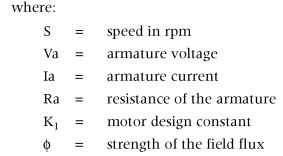
As seen in the formula, if the load on the motor remains constant, the armature current will stay constant, as well as the resistance of the armature. In addition, the motor design constant will remain the same, as well as the strength of the field flux. When all of these components remain
constant, the only determining factor in speed is the amount of armature voltage applied.
The above formula will work in determining speed, when at or below the base speed of the motor. The formula will also indicate speed, when operating above base speed. It is possible to operate in an extended speed range, as long as the motor manufacturer is consulted for the maximum safe operating speed.
As shown in the formula, if armature voltage is at maximum and all the other components remain constant, speed can possibly be increased by reducing the field flux (Q). It is necessary to point out, however, that this must be done with caution.
Reduced field flux is the result of reducing the voltage from the field exciter. If voltage is reduced to near zero, the speed of the armature can increase to the point of motor self-destruction. This operation above base speed is known as the field weakening speed range, for apparent reasons. The field exciter will have safeguards in place to avoid excessive speed. Most DC drive systems will allow a field weakening range of no less than 1/3 of the normal voltage. If the voltage drops to less than that amount, pre-programmed safety circuits in the drive shut down the armature supply and bring the motor to a safe stop.
Increased speed is made possible by a reduced amount of field flux, when operating above base speed. In essence, less EMF is available to act as holdback magnetic flux. Torque available from the motor is also a function of speed.
Typical armature voltage ratings in the United States are 90, 180, 240, or 500 VDC. Typical U.S. field voltage ratings are 100, 200, 150, or 300 VDC. As stated earlier, the amount of voltage applied to the armature would dictate the output shaft speed. For example, if a 1750-rpm motor with a 240 VDC armature had 120 VDC applied (1/2 voltage), the shaft speed would be approximately 875 rpm (1/2 speed).
Control of Torque
Under certain conditions, motor torque remains constant when operating below base speed. However, when operating in the field weakening range, torque drops off inversely as 1/speed2. The amount of motor torque can also be determined by a formula. The following relationship exists in a DC motor and serves to help determine the motor torque available:
![]()
where:
T = torque developed by the motor K1 = motor design constant

As seen in the formula, if the field flux is held constant, as well as the design constant of the motor, then the torque is proportional to the armature current. The more load the motor sees, the more current is consumed by the armature.
A selling point of DC motors is their ability to provide full torque at zero speed. This is accomplished by the two power supplies, energizing their power structures to supply voltage to the armature and field. When additional load is dropped across the armature, magnetic flux of the armature cuts through the field flux. Once this occurs, more current is drawn through the armature, and the drive’s power structure conducts the required amount of current to meet the demand. This phenomenon occurs whether the motor is at any speed, including zero.
Enclosure Types and Cooling Methods
There are various types of enclosures associated with DC motors. The following are the more common configurations found in industry. The system of cooling or ventilation is inherent in the enclosure design. In most cases, to allow the motor to develop full torque at less than 50% speed, an additional blower is required for motor cooling.
DPFG (Drip-Proof Fully Guarded)
The drip-proof fully guarded (DPFG) type of enclosure is self-ventilated and has no external means of cooling. In many cases, these types of motors can be modified to accept additional outside air. Most DPFG designs can generate 100% rated torque down to 50% of base speed. Figure 3-8 shows a DPFG motor.
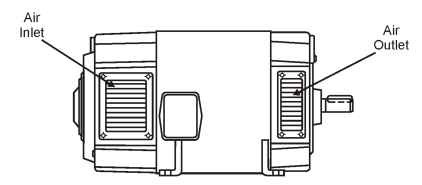
Figure 3-8. DPFG motor
DPBV (Drip-Proof Blower Ventilated)
The drip-proof blower ventilated (DPBV) type of enclosure has an integral blower, which may or may not include a filter. The blower is typically mounted on the commutator end to provide constant cooling airflow. It is
not uncommon for blower ventilated motors to deliver 100% rated torque down to 10 or 5% of base speed. Figure 3-9 shows a DPBV motor.
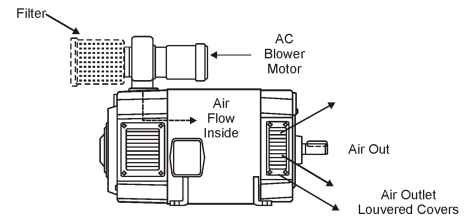
Figure 3-9. DPBV motor
DPSV (Drip-Proof Separately Ventilated)
The drip-proof separately ventilated (DPSV) type of enclosure uses ducted air in the CFM amount required to cool the motor. This type of motor is capable of delivering 100% torque down to 10 or 5% of base speed. In many cases, this type is suitable for use in hazardous or contaminated environments. Figure 3-10 indicates a DPSV motor.
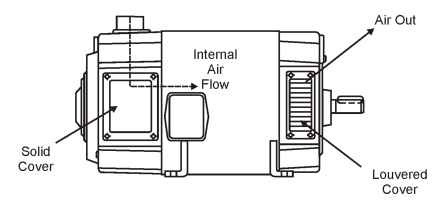
Figure 3-10. DPSV motor
TESV (Totally Enclosed Separately Ventilated)
The totally enclosed separately ventilated (TESV) type of enclosure has air flow ducted into and out of the motor in the CFM amount required for cooling. This type of motor is capable of delivering 100% torque down to 10 or 5% of base speed. In many cases, this type is suitable for use in hazardous or contaminated environments. Figure 3-11 indicates a TESV motor.
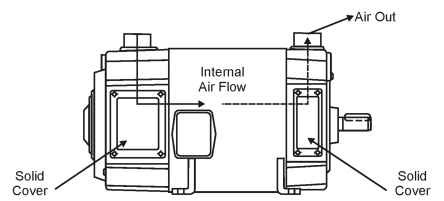
Figure 3-11. TESV motor (Courtesy of Emerson Motors Technologies™)
TENV (Totally Enclosed Non-Ventilated)
The totally enclosed non-ventilated (TENV) type of enclosure has no external cooling, but uses an internal fan to circulate the air within the motor. This type of motor is capable of delivering 100% torque down to 10 or 5% of base speed. Due to the cooling effects, these types of enclosures are not practical for large horsepower ratings. For a comparison, a 100-HP open drip motor would be the approximate equal size of a 30-HP TENV motor. Figure 3-12 indicates a TENV motor.
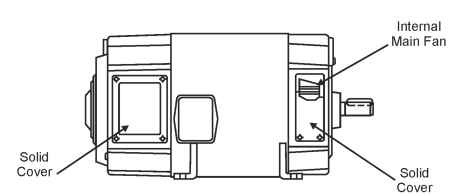
Figure 3-12. TENV motor
TEAO (Totally Enclosed Air Over)
The totally enclosed air over (TEAO) type of enclosure has a blower mounted directly on top of the motor. This allows for constant air flow over the external surface of the motor frame. There is no internal cooling effect taking place, only around the outside of the unit. Motors of this type are capable of delivering 100% torque down to approximately 10% of base speed. Figure 3-13 indicates a TEAO motor.
TEFC (Totally Enclosed Fan Cooled)
The totally enclosed fan cooled (TEFC) type of enclosure has an externally mounted fan on the commutator end shaft. Air flow is a direct result of the
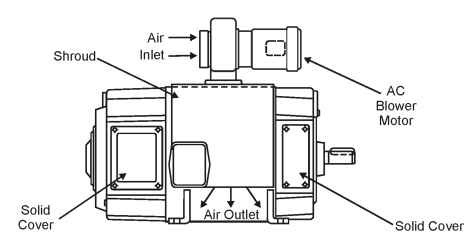
Figure 3-13. TEAO motor
speed of the motor. Because of this fact, this type of enclosure is not suitable for low-speed applications. These types of motors are capable of delivering 100% torque down to 60% of base speed. Figure 3-14 indicates a TEFC motor.
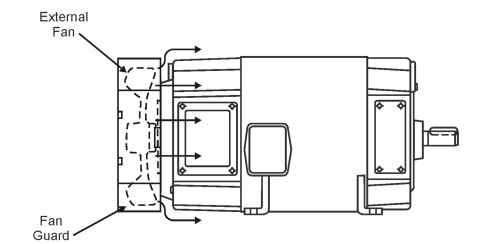
Figure 3-14. TEFC motor
TEUC (Totally Enclosed Unit Cooled)
The totally enclosed unit cooled (TEUC) type of enclosure uses an air-to-air heat exchanger and receives its cooling through an external blower. The blower draws air into the heat exchanger through the air inlet. An internal blower circulates the internal cooled air throughout the inside of the motor. The external and internal blowers are in two separate chambers to restrict the mixing of outside and inside air.
These types of motors are able to deliver 100% rated torque down to 3 or 2% of base speed (20:1 constant torque applications). Figure 3-15 indicates a TEUC motor.
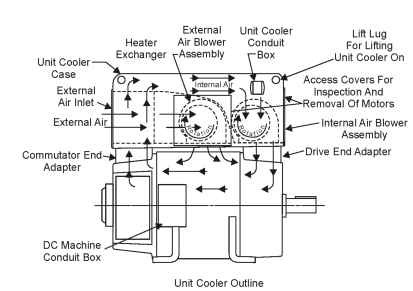
Figure 3-15. TEUC motor
Protection and Ratings
As with any electrical device, motors must be kept safe from harmful elements, or their performance and lifespan will be diminished. Elements such as carbon or metal dust particles, and acids and salts, are all excellent conductors. These materials, wet or dry, can conduct current at very low voltages and across very small gaps. Also, water or condensation can seriously degrade the insulation system of a motor. Water with chemicals or minerals is a conductor and can promote leakage currents, causing premature failure.
In many industrial atmospheres, oily compounds are present, which are deposited on all surfaces over a period of time. These surfaces begin to accumulate contaminates, which can develop a short in motor commutators or in brush riggings. Here again, leakage currents can also develop, causing long-term degrading of motor insulation and eventual motor failure.
The following items need to be reviewed periodically to ensure trouble-free operation.
Over Temperature Conditions
Placing the motor into overload conditions is one cause of over-temperature. High ambient temperatures and dirty or clogged air filters on the machine or motor blowers also contribute to over-temperature failures. High temperature inside the motor cause expansion stress in the wire insulation, resulting in cracks, which in turn can cause contamination and eventual wire failure. The shrinking and hardening of the wire lacquer insulation is a cause for loss of insulation strength.
Ambient Temperature
Typical recommendations are for the motor ambient conditions not to exceed 40oC (104oF). Most motors are designed for continuous operation at this ambient temperature. However, motors that will continuously be used in higher temperatures will typically be designed with a lower temperature rise class of insulation.
DC motor insulation must have mechanical and dielectric strength. It must withstand the normal handling necessary in the assembly of the motor, as well as operation thereafter. The major insulation classes are A, B, F, and H, and a brief description is as follows:
• Class A is the lowest grade, suitable for typical household appliances, but not normally industrial applications.
• Class B is general purpose, used in many industrial applications. More demanding duty requires Class F or Class H.
• Class H is the heavy-duty insulation, capable of withstanding high ambient and internal motor temperatures.
Normal life expectancy of an insulation system is 10,000 to 15,000 hours of operation, depending on temperature. Reducing the motor’s winding temperature by 10°C will double the insulation life. Conversely, increasing the temperature by 10°C will cut the life expectancy in half.
If you need more information, contact a local motor distributor, NEMA (National Electrical Manufacturers Association) or a local representative of EASA (Electrical Apparatus Service Association).
If the ambient temperature is above 50oC, special consideration must also be made for the bearing and shaft lubricants. The motor manufacturer must always be consulted when continuous temperatures rise above this value.
Vibration
Vibration causes problems such as shaft stress and eventual shorting of conductors between winding turns or between layers of windings. Severe vibration can cause cracks in the lacquer insulation, which exposes the conductors to contamination. Commutation problems may also develop from the “bouncing” of brushes on the commutator. Continuous vibrations tend to cause metal fatigue, which may a cause for premature casting (frame) or bearing failure.
Altitude
Standard motor ratings are based on operation at altitudes of up to 3300 feet (1000 m) ASL (above sea level). Many manufacturers recommend the user to lower the motor rating by 1% for every 330 feet above 3300 feet ASL. The reason is that the air is less dense at higher altitudes (less air molecules to take the heat away from the motor frame). To reduce the need
for lowering the rating a motor-mounted blower normally will be sufficient to cool the motor and prevent overheating.
Protection
Most motor manufacturers encourage the purchase and use of a motor thermostat. This device is typically a bi-metallic disk or strip that is sensitive to temperature rise. When the temperature reaches a predetermined level, the thermostat acts as a switch and opens a control circuit, which in turn shuts down the motor. (When a drive is connected to a motor, this thermostat is connected to an auxiliary circuit that shuts down the drive when over-temperature conditions arise.)
The thermostat is mounted on a commutating coil inside the motor, which means the device needs to be installed at the time of manufacture. Standard configuration is a normally closed contact. However, normally open configurations are also available.
This type of device usually retails for about $150 and is very reasonable insurance against motor overheating. Once a motor overheats, insulation damage can occur, causing thousands of dollars in repair costs and additional costs in down time.
Ratings
Typical DC motors have ratings that are found on the nameplate. Figure 316 indicates a typical DC motor nameplate.
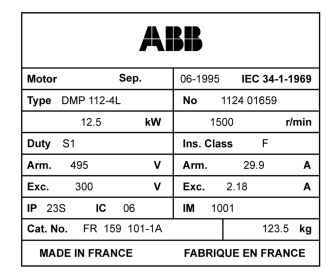
Figure 3-16. DC motor nameplate
• Frame: indicating the frame rating per specific horsepower and torque capability.
• HP: available horsepower at the designated armature and field voltage and current ratings.
• Amps/field amps: designations for armature and field winding amps, respectively. These ratings are needed when programming the protection features in a drive controller.
• Base/max. speed: indicates the rated speed in rpm, when operating at rated armature and field amps, as well as rated load. The max speed indication is the maximum safe operating rpm possible, while remaining within the limitations of the motor.
Additional ratings include enclosure type, thermostat type, ambient temperature rating, catalog and serial number, and tachometer type and rating. These ratings have been previously discussed. Refer to topic 5 “Drive Control and Feedback Devices,” for more information on tachometers.
Most DC motors also carry one of three duty ratings:
• Continuous duty: rating given to motors that will continuously dissipate all the heat generated by internal losses without exceeding the rated temperature rise.
• Intermittent duty (definite time): rating given to a motor that carries a rated load for a specified time without exceeding the rated temperature rise.
• Intermittent duty (indefinite time): rating given to a motor that is usually associated with some RMS load of a duty-cycle operation.
• Peak torque: the peak torque that a DC motors can deliver is limited by the load point at which damaging commutation begins. Brush and commutator damage depends on the sparking severity and duration. Peak torque is limited by the maximum current that the power supply can deliver.
• Calculating torque: An easy means of calculating the available torque from a DC motor is to use the following formula:
where:![]()
Torque = torque available from the motor in lb-ft HP = nameplate horsepower at base speed Speed = rpm
As an example, assume a 10-HP DC motor has a 240-V armature, 39.2 amp with a speed of 1775/2750. We will insert the needed numbers into the formula and determine the base speed (1775) torque:

The above formula will work for determining torque at any speed up to base speed. (Again, remember that base speed in rated: armature voltage, field current, and load.)
To determine the torque per amp ratio, simply divide 29.5 by 39.2, which equals 0.75 lb-ft of torque per amp. Determining the torque per amp ratio above base speed is also possible by calculating the torque, using the above formula for the speed over base, then using the ratio of the calculated torque and the amp meter reading at that speed. As expected, the amount of torque developed is less, above base speed, compared with below base speed.
DC Motor Types
Introduction
Basically, four different types of DC motors are used in industrial applications: series wound, shunt wound, compound wound, and permanent magnet. Several factors must be considered when selecting a DC motor for a specific application.
First, decide what the allowable variation in speed and torque can be for a given change in load. Each type of motor has benefits that are advantageous for certain applications. The following review will help you decide which motor may provide better performance in a given application. The DC motor and drive specifications should always be consulted to determine the specific speed and torque capabilities of the system. The speed/ torque curves listed below are for illustrative purposes.
Series Wound DC Motors
A series wound DC motor has the armature and field windings connected in a series circuit. Figure 3-17 shows a series wound DC motor, with an associated speed/torque curve.
As seen in Figure 3-17, this type of motor configuration features very high breakaway torque. Typical applications for this motor would be printing presses, ski lifts, electric locomotives, cranes, and oil drilling.
The starting torque developed can be as high as 500% of the full load rating. The high starting torque is a result of the fact that the field winding is operated below the saturation point.
An increase in load will cause a corresponding increase in both the armature and field winding current, which means that both armature and field winding flux increase together. As you recall, the torque developed in a DC motor is the result of the interaction of armature and field winding fluxes. Torque in a DC motor increases as the square of the current value.
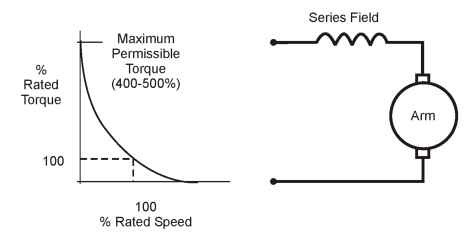
Figure 3-17. Series wound DC motor circuit and curve
A series wound DC motor will generate a larger torque increase compared with a shunt wound DC motor for given increase in current.
Conversely, the speed regulation of a series wound DC motor is poorer than that of a shunt wound motor. As stated above, when the load increases, so does the armature and field winding current. When the load is reduced, so is the current, which causes a corresponding decrease in flux density. As a reminder of DC motor basics, when the field flux is reduced once the motor is running, a decrease in “hold-back” electromotive force (EMF) occurs. Therefore, when the load is reduced, speed increases. If the load were completely removed, the speed of the motor would increase to infinity—basically until the motor destroys itself. As a safety precaution, series wound DC motors should always be connected to a load.
Parallel (Shunt) Wound DC Motors
A shunt wound DC motor has the armature and field windings connected in parallel. Figure 3-18 shows a shunt wound DC motor, with an associated speed/torque curve.
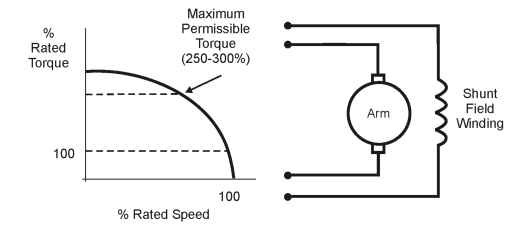
Figure 3-18. Shunt wound DC motor and curve
This type of DC motor is probably the most widely used motor in industrial applications. As indicated in the figure, this type of motor requires two power supplies—one for the armature and one for the field winding.
Typical applications for this motor would be printing presses, ski lifts, plastic extruders, conveyors, and practically any other application where DC motors are used. Because of the need for two power supplies, this type of motor is a prime candidate for a DC drive (converter), which usually includes a low-current field winding exciter (power supply).
With constant armature voltage and field winding excitation, this type of motor offers relatively flat speed/torque characteristics. The starting torque developed can be 250-300% of the full load torque rating for a short period of time. Speed regulation (speed fluctuation due to load) is acceptable in many cases between 5-10% of maximum speed, when operated from a DC drive. Regulation of this amount would be typical when operated from a drive controller, open loop (no electronic feedback device connected to the motor shaft). As discussed in topic 5, speed feedback devices such as a tachometer generator can dramatically improve the regulation (down to less than 1%).
Because of the need for two power sources, the shunt wound DC motor offers the use of simplified control for reversing requirements. Direction of any shunt wound motor can be changed by simply reversing the direction of current flow, in either the armature or shunt field winding. The capability of armature or field reversal is standard on many DC drive modules. (In many cases, the reversing of flux and direction is accomplished in the field winding control. The field winding consumes less than one tenth of the current compared with the armature circuit. Smaller components and less stress on circuitry is the result when “field reversal” is used for DC motor control.)
Compound Wound DC Motors
A compound wound DC motor is basically a combination of shunt wound and series wound configurations. This type of motor offers the high starting torque of a series wound motor. In addition, it offers constant speed regulation (speed stability) under a given load. This type of motor is used whenever speed regulation cannot be obtained from either a series or shunt wound motor. Figure 3-19 indicates a compound wound DC motor, with an associated speed/torque curve.
The torque and speed characteristics are the result of placing a portion of the field winding circuit in series with the armature circuit. This additional armature winding circuit is not to be confused with the commutating winding or interpoles. The commutation windings also have a few turns, but have the duty of neutralizing armature reaction.
When a load is applied, there is a corresponding increase in current through the series winding, which also increases the field flux. This in turn increases the torque output of the motor.

Figure 3-19. Compound wound DC motor and curve
Permanent Magnet DC Motors
A permanent magnet motor is built with a standard armature and brushes, but has permanent magnets in place of the shunt field winding. The speed characteristic is close to that of a shunt wound DC motor. When adding the cost of a DC motor and control system, this type of motor is less expensive to operate, since there is no need for a shunt field winding exciter supply. Figure 3-20 indicates a permanent magnet DC motor, with an associated speed/torque curve.
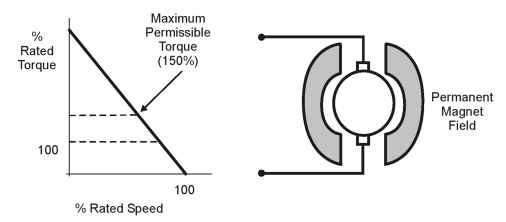
Figure 3-20. Permanent magnet DC motor and curve
Along with less expensive operation, this type of motor is simpler to install, with only the two armature connections needed. This motor type is also simpler to reverse—simply reverse the connections to the armature.
The permanent magnet poles are usually constructed of materials such as ceramic or alnico (aluminum, nickel, and cobalt). The ceramic magnets are used for low-horsepower, slow-speed applications because of their low
flux level generation. Though this type of motor has good operational characteristics and lower cost, there are several drawbacks to this type of motor compared with the others.
Materials such as ceramic have a high resistance to demagnetization. However, permanent magnets do have a tendency to lose some of their magnetic strength over use and time. This reduction in magnetic field strength causes a corresponding reduction in torque output. To counteract this possibility, some higher-cost permanent magnet motors include windings built into the field magnets for the purpose of “re-magnetizing” the magnets.
In addition to ceramic or alnico magnets, rare earth magnets are also a cost-effective means of generating magnetic field flux. This type of magnetic group includes the “embedded” magnet, which is only one of nine different magnetic materials available.
Though this type of motor has very good starting torque capability, the speed regulation is slightly less than that of a compound wound motor. The overall torque output makes this motor a prime candidate for low-torque applications. Peak torque is limited to about 150%. This limitation is based on the fact that additional “demagnetizing” of the field poles could occur if more torque was developed.
Specialty DC Motors—PM DC Servomotors
Servomotors are considered “specialty” in that they are used in applications that require very fast speed response and accuracy. In many cases, the shaft speed is accelerated from zero to 6000 rpm in hundredths of a second. The same speed profile could be needed in the deceleration mode, as well as an immediate reversal of direction.
These types of motors must be designed to handle the stress of acceleration, plus not fluctuate in speed, once the desired speed is obtained. Special consideration is given to heat dissipation, since these motors must be small, yet generate enough torque to operate the machine. The small size allows this type motor to fit inside small packaging, palletizing, and processing machines. Typically, these motors are long and narrow, in contrast to a standard shunt wound DC motor. The long, narrow design results in low inertia armature assemblies, which can be accelerated quickly. Servomotor design with permanent magnets affords the smallest space possible. In comparison, shunt field windings must have laminations wide enough to generate the necessary field flux, which adds to the total width of the machine. Figure 3-21 indicates the physical appearance of a typical DC servomotor.
As seen in Figure 3-21, this type of motor is usually of a totally enclosed design to seal out most moisture, dust, and moderate contaminates. The physical frame of the motor acts as a heat sink to dissipate the heat generated.
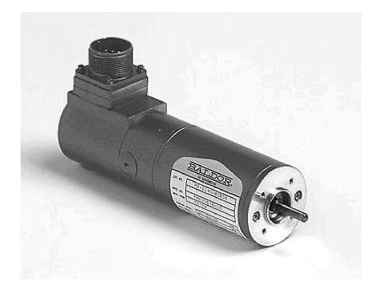
Figure 3-21. DC servomotor with C face mounting
Many servomotors are used expressly for positioning applications. Therefore, the motor design allows for a position feedback device such as an encoder or resolver. Mounting of the servomotor can be easily done by means of a “C” face (no flange, but tapped holes to receive mounting bolts) or “D” flange (outside flange with through-holes).
The principle involved in the PM servomotor is exactly the same as the standard PM DC motor. It has an armature, commutator, and the PM field for magnetic interaction. The difference comes in the physical size and shape of the servomotor, as well as the performance and speed characteristics.
Specialty DC Motors—Brushless Servomotors
Another type of DC servomotor uses the high-torque and acceleration characteristics, but without the use of a commutator or brushes. This type, called the brushless DC servomotor, takes input three-phase or single-phase input power and converts it to DC used by the motor windings. The windings create magnetic flux that interacts with the PM field to generate motor speed and torque. Figure 3-22 shows the design of the brushless DC servomotor.
As seen in Figure 3-22, instead of the permanent magnets being mounted as the field, the magnets are actually part of the rotor. (Note: Since there are no brushes or commutator, the term “rotor” is used instead of armature, indicating an AC-type machine design.) A typical brushless DC servomotor may have multiple poles, such as three N and three S poles. There would also be corresponding windings in the stator to create the magnetic interaction. (Note: Because this is an AC-type machine design, the term “stator” is used instead of “field” or “field windings.”)
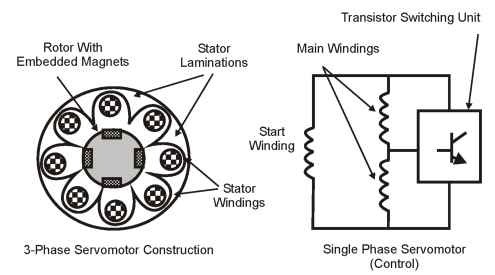
Figure 3-22. Brushless DC servomotor (design and control)
The rotor of the servomotor is usually laminated iron with magnets inserted and “press-fit” or epoxied into position. Special high-speed bearings support the rotor in position. Instead of a standard conduit box, servomotors usually include a military-style connector. This style features all connections on one plug or receptacle, with a screw-on ring to ensure positive contact. This style of connector is resistant to machine vibration and electrical interference.
The servomotor takes input power and converts it to DC for the main windings in the stator. Depending on the design of the servomotor, the control unit may include transistors that are turned on or off to generate voltage. In the case of a three-phase servomotor, an external servo amplifier is connected to generate the control voltage for the stator windings.
The main disadvantage of this motor is the inability to develop high starting torque. In the case of a single-phase servomotor, half of the main windings are used at any given time. This causes the copper losses to be somewhat high. However, since transistor switching is used for control of the brushless DC servomotor, motor life is mainly limited by the bearings, since there are no commutator segments or brushes to wear out.
